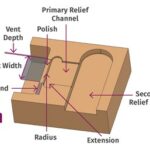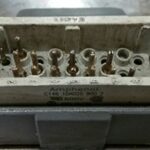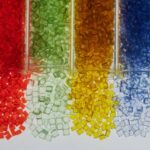

As explored by Xometry in their informative piece "What Are Injection Molded Products?", injection molding stands as the most cost-effective method for large-scale production of plastic parts. The technique involves the precise injection of molten plastic into a pre-designed mold tool, followed by the rapid solidification of the part. This cycle can be repeated hundreds to thousands of times, allowing for the mold cost to be spread over a large number of units, thereby significantly reducing the per-unit cost. Injection molding is not only limited to plastics but is also adaptable for materials such as metals and glasses. It surpasses... Read More

In the article "Hot Runners: A View from the Bottom Up" from Plastics Technology Online, an industry veteran shares insights gained over years of hands-on experience in the realm of hot runners. With a career spanning back to 1988, the author offers a unique perspective, having worked extensively on maintaining and troubleshooting hot runners across a multitude of molds worldwide. Hot runners have evolved significantly, offering a multitude of benefits in today's injection molding landscape. They eliminate cold sprue and runner, thus reducing scrap and saving costs on regrind. Direct gating onto the part with low-vestige tips or valve gates... Read More

As detailed in Design World Online's article "How injection molding can help power wheelchair applications," Barry and Jered Dean found themselves facing a significant challenge: ensuring the safety of Barry's daughter, Katherine, in her power wheelchair. After experiencing injuries due to a wheelchair accident, they decided to take matters into their own hands. With Barry, a Grammy-nominated Nashville songwriter, and Jered, a design engineer, at the helm, they conceptualized LUCI—an attachable accessory system for power wheelchairs. Partnering with Protolabs, they brought LUCI to life, integrating smart technology to enhance stability, security, and connectivity. LUCI's innovative hardware and software provide power... Read More

In "Back to Basics on Mold Venting (Part 2: Shape, Dimensions, Details)," the intricacies of optimizing mold venting for maximum processing efficiency are explored. The article underscores the importance of vent depth, which should be maximized without causing flash, considering factors such as material type, part geometry, and process parameters. Notably, vent depth recommendations vary based on material viscosity and wall thickness, emphasizing the need for a nuanced approach to vent design. The correlation between wall thickness and vent depth is elucidated, drawing insights from research conducted by Suhas Kulkarni and Distinctive Plastics. It is demonstrated that as wall thickness... Read More

In the article "Hot Runners: How to Maintain Heaters, Thermocouples, and Controls," the evolution of hot runner systems is explored, emphasizing advancements in design and maintenance practices. Notably, the shift towards threading hot drops to the manifold has mitigated common maintenance challenges associated with stack height and seal rings. Despite initial concerns about the complexity of threaded systems, improved designs and coatings have alleviated maintenance burdens, marking a significant improvement in hot runner technology. Addressing common apprehensions among toolmakers regarding hot runner maintenance, the article demystifies the simplicity of these systems' design and wiring. It underscores the importance of proper... Read More

In "Back to Basics on Mold Venting (Part 1)," the complexity of mold venting and its crucial role in both part quality and mold longevity are underscored. As emphasized, understanding the dynamics inside the mold is fundamental to making informed decisions about vent placement, size, and depth. The article explains that while vents must release air during injection molding, they must prevent plastic from escaping, akin to the function of a garden hose spigot. Flow rate emerges as a pivotal factor dictating venting needs. Plastic injection rates, determined by barrel size and injection velocity, directly influence the requisite venting capacity.... Read More

In the intricate realm of injection molding, where precision is paramount, we delve into the fundamental concept of tonnage and its role in the molding process. At its core, injection molding involves the strategic injection of molten plastic into a closed mold, with tonnage serving as the force that keeps the mold halves intact during the injection process. Understanding Tonnage in Injection Molding: At its most basic level, injection molding requires the application of tonnage, a force that prevents the separation of mold halves during the injection of molten plastic. The pressures exerted during injection are designed to keep the... Read More

In the realm of manufacturing, plastic injection molding, also known simply as injection molding, takes center stage. This widely employed process facilitates the mass production of plastic parts by injecting molten plastic into a pre-designed mold or cavity. The versatility of plastic injection molding makes it a preferred choice across industries, including automotive, electronics, consumer goods, and medical devices. This process delves into the intricacies, shedding light on its advantages and disadvantages. Advantages of Plastic Injection Molding: Cost-Effective Mass Production: Plastic injection molding proves highly efficient for mass production, minimizing material waste and ensuring cost-effectiveness for high-volume runs. Precision and... Read More
As detailed in Xometry's article "Basics of Plastic Injection Molding," plastic injection molding stands as a widely utilized manufacturing technique, transforming thermoplastic pellets into intricate and high-volume components. This pivotal process plays a crucial role in various aspects of modern life, from phone cases and electronic housings to toys and automotive parts. In this breakdown of injection molding essentials, we delve into the intricacies of the process, elucidate its workings, and draw comparisons with 3D printing. The Basics of Plastic Injection Molding: The plastic injection molding process begins with the creation of a product design, followed by the fabrication of... Read More

In the evolving landscape of manufacturing, the role of automation in injection molding and moldmaking is becoming increasingly indispensable. Recognizing the urgency, especially in the face of a growing skilled labor shortage, to apply robotics to tasks crucial for the industry's survival but challenging to fill with human labor. Highlighted in the source content "Injection Molding and Moldmaking Automation in Focus," the upcoming Molding and Moldmaking Conferences in Minneapolis, Minn. (August 29-30) will feature presentations addressing automation in these industries. This presents a valuable opportunity for attendees to gain insights from both suppliers and users of automation, exploring the scope... Read More